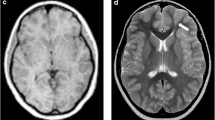Abstract
Positron emission tomography (PET) imaging is in common use preoperatively to clinically evaluate patients who present with central nervous system mass lesions. The usefulness of PET is also recognized as a method to detect intracranial tumorous lesions. A number of papers report that some inflammatory processes also showed the uptake of Fluorine-18-Fluorodeoxyglucose (FDG) and Carbon-11-Methionine (Met) tracers. We performed two PET studies before and after treatment in 4 patients with brain abscess. PET showed the uptake of both tracers to the brain abscess before treatment. The area showing an increased uptake of Met corresponded closely to the enhanced area on both CT and MR images. FDG-PET visually showed an uptake of FDG in a small area corresponding to an enhanced lesion within the CT and MR images. After treatment the area of lesions became small on enhancement CT or MRI and both PET studies showed reduced lesion and decreased uptake. The mechanism of Met uptake in the inflammatory area may be related to the higher metabolic rate and the active transport of amino acids as well as disruption of the blood brain barrier. Furthermore, it appears that the mechanism of FDG uptake is also related to a higher metabolic rate and, in addition, is related to the increased density of inflammatory cells. PET studies, more directly, reflect the degree of inflammatory response in brain abscess than enhancement CT or MRI. Therefore, PET is useful in detecting the inflammatory lesion and assessing the clinical effects of antibiotics treatment on brain abscesses.
Similar content being viewed by others
References
Coleman RE, Hoffman JM, Hansom MW, Sostman HD, Schold SC. Clinical application of PET for the evaluation of brain tumors.J Nucl Med 1991; 32: 616–622.
Di Chiro G. Positron emission tomography using [18F] Fluorodeoxyglucose in brain tumors: A powerful diagnostic and prognostic tool.Invest Radiol 1986; 22: 360–371.
Ichiya Y, Kuwabara Y, Sasaki M, Yoshida T, Akashi Y, Murayama S, et al. FDG-PET in infectious lesions: The detection and assessment of lesion activity.Ann Nucl Med 1996; 10: 185–191.
Sugawara Y, Braun DK, Kison PV, Russo JE, Zasadny KR, Wahl RL. Rapid detection of human infections with fluorine-18 fluorodeoxyglucose and positron emission tomography: preliminary results.Eur J Nucl Med 1998; 25: 1238–1243.
Yen RF, Chen ML, Liu FY, Ko SC, Chang YL, Chieng PU, et al. False-positive 2-[F-18]-fluoro-2-deoxy-d-glucose positron emission tomography studies for evaluation of focal pulmonary abnormalities.J Formos Med Assoc 1998; 97: 642–645.
Tahara T, Ichiya Y, Kuwabara Y, Otsuka M, Miyake Y, Gunasekera R, et al. High [18F]-fluorodeoxyglucose uptake in abdominal abscesses: a PET study.J Comput Assist Tomogr 1989; 13: 829–831.
Mineura K, Sasajima T, Kowada M, Ogawa T, Hatazawa J, Uemura K. Indications for differential diagnosis of nontumor central nervous system diseases from tumors. A positron emission tomography study.J Neuroimaging 1997; 7: 8–15.
Sasaki M, Ichiya Y, Kuwabara Y, Otsuka M, Tahara T, Fukumura T, et al. Ringlike uptake of [18F] FDG in brain abscess: a PET study.J Comput Assist Tomogr 1990; 14: 486–487.
Meyer MA, Frey KA, Schwaiger M. Discordance between F-18 fluorodeoxyglucose uptake and contrast enhancement in a brain abscess.Clin Nucl Med 1993; 18: 682–684.
Ishii K, Ogawa T, Hatazawa J, Kanno I, Inugami A, Fujita H, et al. Highl-methyl-[11C] methionine uptake in brain abscess: a PET study.J Comput Assist Tomogr 1993; 17: 660–661.
Dethy S, Manto M, Kentos A, Konopnicki D, Pirotte B, Goldman S, et al. PET findings in a brain abscess associated with a silent atrial septal defect.Clin Neurol Neurosurg 1995; 97: 349–353.
Kubota K, Matsuzawa T, Fuziwara T. An experimental study on differetial diagnosis of cancer from inflammation using11C-l-methionine.KAKU IGAKU (Jpn J Nucl Med) 1985; 22: 1327–1332.
Dethy S, Goldman S, Blecic S, Luxen A, Levivier M, Hildebrand J. Carbon-11-methionine and fluorine-18-FDG PET study in brain hematoma.J Nucl Med 1994; 35: 1162–1166.
Ogawa T, Hatazawa J, Inugami A, Murakami M, Fujita H, Shimosegawa E, et al. Carbon-11-methionine PET evaluation of intracerebral hematoma: distinguishing neoplastic from non-neoplastic hematoma.J Nucl Med 1995; 36: 2175–2179.
Ishiwata K, Kubota K, Murakami M, Kubota R, Sasaki T, Ishii S, et al. Re-evaluation of amino acid PET studies: can the protein synthesis rates in brain and tumor tissues be measuredin vivo? J Nucl Med 1993; 34: 1936–1946.
Schifter T, Hoffman JM, Hanson MW, Boyko OB, Beam C, et al. Serial FDG-PET studies in the prediction of survival in patients with primary brain tumors.J Comput Assist Tomogr 1993; 17: 509–516.
Som P, Atkins HL, Bandoypadhyay D, Fowler JS, MacGregor RR, Matsui K, et al. A fluorinated glucose analog, 2-fluoro-2-deoxy-d-glucose (F-18): nontoxic tracer for rapid tumor detection.J Nucl Med 1980; 21: 670–675.
Kubota R, Yamada S, Kubota K, Ishiwata K, Tamahashi N, Ido T. Intratumoral distribution of fluororine-18-fluorodeoxyglucosein vivo: high accumulation in macrophages and granulation tissues studied by microautoradiography.J Nucl Med 1992; 33: 1972–1980.
Yamada S, Kubota K, Kubota R, Ido T, Tamahashi N. High accumulation of fluorine-18-fluorodeoxyglucose in turpentine-induced inflammatory tissue.J Nucl Med 1995; 36: 1301–1306.
Fantone JC, Ward PA. Role of oxygen-derived free radicals and metabolites in leukocyte dependent inflammatory reactions.Am J Pathol 1982; 107: 395–418.
Author information
Authors and Affiliations
Corresponding author
Rights and permissions
About this article
Cite this article
Tsuyuguchi, N., Sunada, I., Ohata, K. et al. Evaluation of treatment effects in brain abscess with positron emission tomography: Comparison of fluorine-18-fluorodeoxyglucose and carbon-11-methionine. Ann Nucl Med 17, 47–51 (2003). https://doi.org/10.1007/BF02988258
Received:
Accepted:
Issue Date:
DOI: https://doi.org/10.1007/BF02988258




